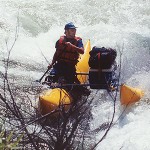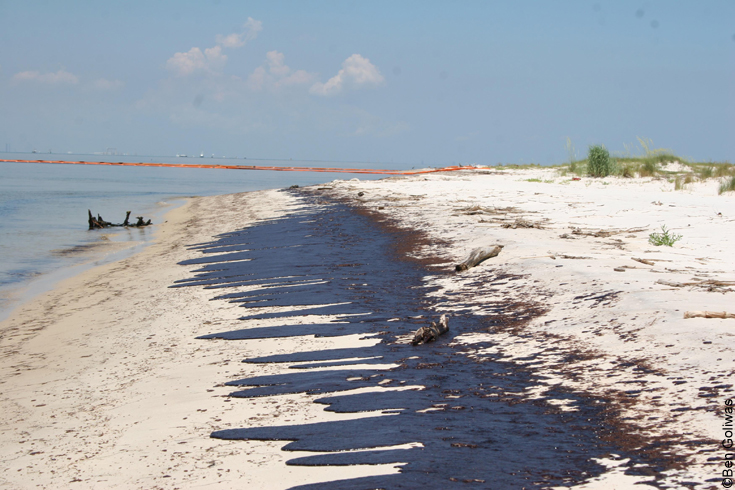Comments Reviews on theboatpeople.com Raft Cataraft Inflatable Kayak Products and Service › Forums › Environmental News › Where Did the BP Deepwater Horizon Oil Go?
Tagged: BP Deepwater Horizon Oil
- This topic has 1 reply, 1 voice, and was last updated 9 years, 3 months ago by
 Lee Arbach TBP.
Lee Arbach TBP.
-
AuthorPosts
-
November 6, 2014 at 6:15 pm #2126
 Lee Arbach TBPKeymaster
Lee Arbach TBPKeymaster
Where Did the BP Deepwater Horizon Oil Go?
You may remember images like this one following the BP Deepwater Horizon oil disaster—oil smeared across Gulf Coast beaches like a dirty bathtub ring. New research released this week suggests that a similar oily bathtub ring is lying on the bottom of the Gulf of Mexico.
Scientists determined that an oily patch created by the BP oil disaster remains on the Gulf seafloor, stretching across roughly 1,250 square miles. They came to these conclusions using data collected as part of the Natural Resources Damage Assessment at over 500 sampling locations in the Gulf. The source of the oil is most likely the subsea oil plumes that moved underwater—oil that spewed from the Macondo wellhead but never made it to the surface. As oiled particles fell out of the plume and settled on the Gulf seafloor, they created what the researchers are calling a “patchwork mosaic” of contaminated sites. The patches get more spread out the further they are from the wellhead, leading the scientists to conclude that there is still more oil lying beyond the edge of the bathtub ring, but it probably just hasn’t been detected yet.
The U.S. government estimates the Macondo well’s total discharge was 210 million gallons. The lead researchers of this study, Christopher Reddy and David Valentine, recognize the challenge of tracking millions of gallons of oil in the deep ocean. “Keep in mind that we’re trying to track 30,000,000,000,000,000,000,000,000,000,000,000 carbon atoms (and twice that number of hydrogen atoms) in a hostile, ever-moving environment,” the authors said in a recent blog. Their research sheds light on the mystery of the submerged oil that never came ashore or reached the Gulf surface.
You might remember earlier studies that supported the hypothesis that microbes in the water column and deep sea consumed large amounts of the BP oil and gas. At first glance, this new study seemed to contradict those findings, but in reality they are complimentary. To understand how all of these pieces fit together, we need to be thinking about two types of hydrocarbons, or the chemical structures of oil and gas particles. First, there are the water-soluble hydrocarbons, which are what the oil-consuming microbes eat. Second, there are the water-insoluble, non-digestible hydrocarbons, which are the types of oil products reported on for this new study. Both studies are helping us understand the fate and distribution of the oil and gas released during the BP oil disaster.
“The evidence is becoming clear that oily particles were raining down around these deep-sea corals, which provides a compelling explanation for the injury they suffered,” said Valentine. “The pattern of contamination we observe is fully consistent with the Deepwater Horizon event but not with natural seeps–the suggested alternative.”
In light of recent attempts by BP to minimize the oil disaster, this study is another link that ties BP to the impacts in the deep waters of the Gulf. As science progresses and new findings emerge, more and more studies are reminding us that this was an offshore disaster, and projects to restore the Gulf are needed offshore, as well as on the coast. So far the vast majority of restoration projects have targeted damaged coastal habitats or lost recreation days due to closed fisheries and beaches. These projects are no doubt important, but in order to achieve full restoration to the Gulf ecosystem there needs to be a shift to a more balanced portfolio that addresses the marine resources, such as fish, sea turtles, dolphins and deep-sea corals, in addition to our beaches, marshes and fishing piers.
http://blog.oceanconservancy.org/2014/10/31/where-did-the-bp-deepwater-horizon-oil-go/
April 20, 2015 at 1:30 pm #2405 Lee Arbach TBPKeymaster
Lee Arbach TBPKeymaster
Five years later, not much has changedWhen BP’s Deepwater Horizon oil rig exploded on April 20, 2010, and sank to the bottom of the Gulf of Mexico, it killed 11 workers and spewed millions of gallons of crude across a huge swath of ocean and coastline. It took 87 days before the flow of oil could be stopped, but the devastation to wildlife and livelihoods continues to this day.
With the support of its allies in Washington D.C., the oil industry has avoided reforms that would make drilling safer. Despite a long chain of failures that led to the blowout, Congress has yet to pass a single law to help prevent future offshore-drilling disasters—even as industry efforts expand in the Gulf and the administration considers opening Atlantic and Arctic waters.
The nation’s costly and dangerous dependence on fossil fuel continues to endanger the lives of U.S. workers, the health of our waters, the lifeblood of coastal economies, and the survival of wildlife. There is a better way—putting necessary safeguards in place while also converting to clean energy sources that can’t spill or run dry. Former offshore-drilling regulator Liz Birnbaum is right: “We have long since reached the point where we should stop drilling for new supplies of oil.”
Five years later, NRDC looks back on the people and places that endured the worst of the disaster, and whose lives continue to be harmed by its impact—and the ongoing blight of the fossil-fuel industry in their waters and on their shores.
-
AuthorPosts
- You must be logged in to reply to this topic.
- Click to share on Facebook (Opens in new window)
- Click to share on Twitter (Opens in new window)
- Click to share on LinkedIn (Opens in new window)
- Click to share on Pinterest (Opens in new window)
- Click to share on Tumblr (Opens in new window)
- Click to share on Reddit (Opens in new window)
- Click to share on Pocket (Opens in new window)
